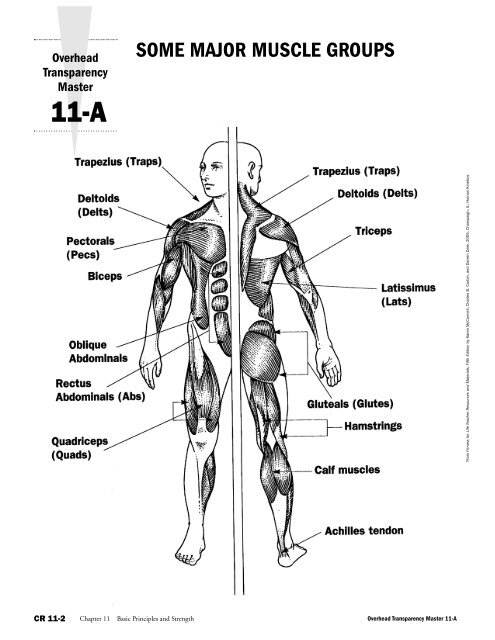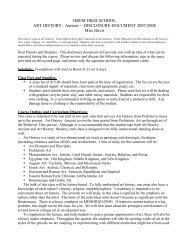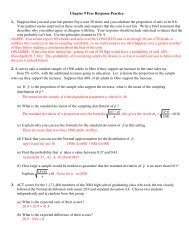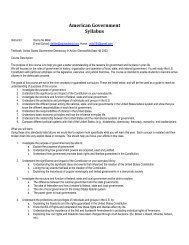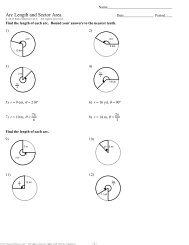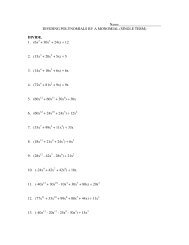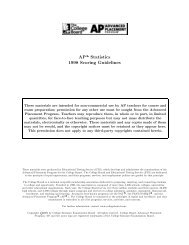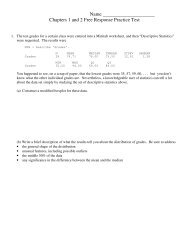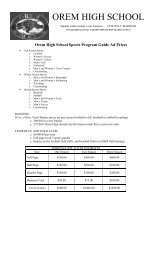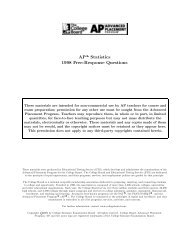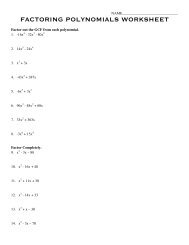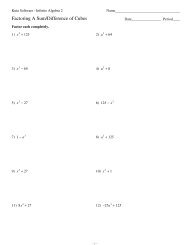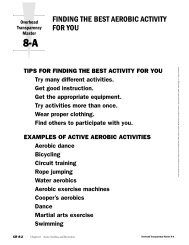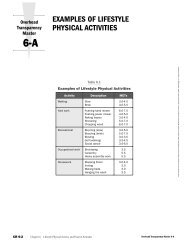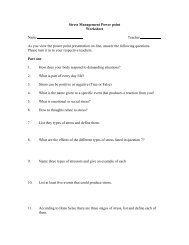SOME MAJOR MUSCLE GROUPS
SOME MAJOR MUSCLE GROUPS
SOME MAJOR MUSCLE GROUPS
Create successful ePaper yourself
Turn your PDF publications into a flip-book with our unique Google optimized e-Paper software.
Overhead<br />
Transparency<br />
Master<br />
11-A<br />
<strong>SOME</strong> <strong>MAJOR</strong> <strong>MUSCLE</strong> <strong>GROUPS</strong><br />
CR 11-2 Chapter 11 Basic Principles and Strength<br />
Overhead Transparency Master 11-A<br />
From Fitness for Life Teacher Resources and Materials, Fifth Edition by Karen McConnell, Charles B. Corbin, and Darren Dale, 2005, Champaign, IL: Human Kinetics.
From Fitness for Life Teacher Resources and Materials, Fifth Edition by Karen McConnell, Charles B. Corbin, and Darren Dale, 2005, Champaign, IL: Human Kinetics.<br />
Overhead<br />
Transparency<br />
Master<br />
11-B<br />
F<br />
I<br />
T<br />
Overhead Transparency Master 11-B<br />
FITNESS TARGET ZONES<br />
FOR STRENGTH<br />
Isotonic Isometric<br />
Frequency Teens 13-14 and older Non-consecutive days;<br />
teen beginners: 2 days/wk 2+ days/wk<br />
on non-consecutive days<br />
Older teens and adults:<br />
2-3 days/wk on<br />
non-consecutive days<br />
Intensity Teens 13-14 and older Contract the muscles as<br />
teen beginners: 40-60% tightly as possible for the<br />
1RM or resistance required length of time.<br />
allowing 10+ reps<br />
Older teens: 40-80% 1RM<br />
or resistance allowing<br />
8+ reps*<br />
Adults: 60-90% 1RM or<br />
resistance allowing<br />
3+ reps<br />
Time Teens 13-14 and older Hold the contraction for<br />
teen beginners: 1 set of 7-10 sec, and rest<br />
10-15 reps for 1+ min. This is 1 set.<br />
Older teens: 1 or 2 sets of Do 2+ sets.<br />
8-12 reps<br />
Adults and adult athletes:<br />
1-3 sets of 3-8 reps<br />
For all groups, rest between<br />
sets 1-2 minutes.<br />
*Note: Older teens and experienced athletes may train using lower repetitions after consulting with a<br />
qualifi ed teacher or coach.<br />
Chapter 11 Basic Principles and Strength<br />
CR 11-3
Overhead<br />
Transparency<br />
Master<br />
11-C<br />
STRENGTH/ENDURANCE CONTINUUM<br />
Pure strength<br />
High Moderate Low<br />
Resistance<br />
(lb)<br />
Low<br />
Moderate<br />
Repetitions<br />
(number)<br />
CR 11-4 Chapter 11 Basic Principles and Strength<br />
Overhead Transparency Master 11-C<br />
High<br />
Pure endurance<br />
From Fitness for Life Teacher Resources and Materials, Fifth Edition by Karen McConnell, Charles B. Corbin, and Darren Dale, 2005, Champaign, IL: Human Kinetics.
From Fitness for Life Teacher Resources and Materials, Fifth Edition by Karen McConnell, Charles B. Corbin, and Darren Dale, 2005, Champaign, IL: Human Kinetics.<br />
Overhead<br />
Transparency<br />
Master<br />
11-D<br />
Overhead Transparency Master 11-D<br />
RESISTANCE MACHINES<br />
VERSUS FREE WEIGHTS<br />
Table 11.6<br />
Resistance Machines Versus Free Weights<br />
Resistance Machines Free Weights<br />
Safety They are safer because weights cannot fall on<br />
the lifter.<br />
A spotter is often not needed.<br />
Cost They are very expensive to own.<br />
If you do not own the machines, you must join a<br />
club to use them.<br />
You have a greater chance of injury from falling weights.<br />
You can easily lose control of the weights, so you need a<br />
spotter.<br />
They are relatively inexpensive.<br />
Versatility They can easily isolate a muscle group to work. Using them requires more balance, muscle coordination,<br />
and concentration.<br />
You use more muscles, and the movements are more<br />
like moving heavy loads in daily life.<br />
Convenience They require a lot of fl oor space.<br />
You must go to where they are.<br />
They take up little space.<br />
Some weights are small enough to be carried around.<br />
They can easily scatter and get lost or stolen.<br />
Chapter 11 Basic Principles and Strength<br />
CR 11-5
Name Class Date<br />
Application<br />
11<br />
CR 11-6<br />
Chapter 11 Basic Principles and Strength<br />
STRENGTH TRAINING<br />
Assume that a few of your friends have found out that they need to build<br />
strength for some of their activities. They have asked you to help them fi gure<br />
out ways to improve their strength. For each of these people, apply the fi tness<br />
principles and the FIT formula to develop a strength training program.<br />
1. Brad is a ballet dancer. He has to lift a female dancer in the dance troupe. His dance instructor thinks that Brad<br />
needs to increase his strength. What program would you advise Brad to follow?<br />
_____________________________________________________________________________________<br />
–––––––––––––––––––––––––––––––––––––––––––––––––––––––––––––––––––––––––––––––––––––<br />
–––––––––––––––––––––––––––––––––––––––––––––––––––––––––––––––––––––––––––––––––––––<br />
–––––––––––––––––––––––––––––––––––––––––––––––––––––––––––––––––––––––––––––––––––––<br />
–––––––––––––––––––––––––––––––––––––––––––––––––––––––––––––––––––––––––––––––––––––<br />
–––––––––––––––––––––––––––––––––––––––––––––––––––––––––––––––––––––––––––––––––––––<br />
2. Adrienne has just begun a part-time job with a moving company. After several days on the job, she realizes that<br />
she lacks the strength to lift many of the heavy pieces of furniture that she is required to move. Adrienne wants<br />
to begin a strength training program, but she does not know which muscles to strengthen or how to strengthen<br />
them. What would you advise her to do?<br />
_____________________________________________________________________________________<br />
–––––––––––––––––––––––––––––––––––––––––––––––––––––––––––––––––––––––––––––––––––––<br />
–––––––––––––––––––––––––––––––––––––––––––––––––––––––––––––––––––––––––––––––––––––<br />
–––––––––––––––––––––––––––––––––––––––––––––––––––––––––––––––––––––––––––––––––––––<br />
–––––––––––––––––––––––––––––––––––––––––––––––––––––––––––––––––––––––––––––––––––––<br />
–––––––––––––––––––––––––––––––––––––––––––––––––––––––––––––––––––––––––––––––––––––<br />
3. Luis has been trying to build his strength through bench pressing. Every Saturday he goes to the club and<br />
does 3 sets of 25 repetitions. When needed, he increases the load he presses. Luis has noticed two problems:<br />
His upper body strength is not increasing as quickly as he thinks it should, and he doesn’t seem to be building<br />
lower body strength at all. How would you change Luis’ workout?<br />
–––––––––––––––––––––––––––––––––––––––––––––––––––––––––––––––––––––––––––––––––––––<br />
–––––––––––––––––––––––––––––––––––––––––––––––––––––––––––––––––––––––––––––––––––––<br />
–––––––––––––––––––––––––––––––––––––––––––––––––––––––––––––––––––––––––––––––––––––<br />
–––––––––––––––––––––––––––––––––––––––––––––––––––––––––––––––––––––––––––––––––––––<br />
–––––––––––––––––––––––––––––––––––––––––––––––––––––––––––––––––––––––––––––––––––––<br />
–––––––––––––––––––––––––––––––––––––––––––––––––––––––––––––––––––––––––––––––––––––<br />
Application 11 Worksheet<br />
From Fitness for Life Teacher Resources and Materials, Fifth Edition by Karen McConnell, Charles B. Corbin, and Darren Dale, 2005, Champaign, IL: Human Kinetics.
From Fitness for Life Teacher Resources and Materials, Fifth Edition by Karen McConnell, Charles B. Corbin, and Darren Dale, 2005, Champaign, IL: Human Kinetics.<br />
Name Class Date<br />
11<br />
Reinforcement<br />
STRENGTH WORD SCRAMBLE<br />
Unscramble the following words using the clues provided. Then write the<br />
letters of the word in the blanks beneath each clue. Use the numbers<br />
under the letters to decode the message at the bottom of the page.<br />
1. IOBALCAN REDOTISS dangerous drugs that build muscle<br />
___ ___ ___ ___ ___ ___ ___ ___ ___ ___ ___ ___ ___ ___ ___ ___<br />
3 1<br />
2. MITCRSEOI RISEEXEC muscles working against a stationary object or body part<br />
___ ___ ___ ___ ___ ___ ___ ___ ___ ___ ___ ___ ___ ___ ___ ___ ___<br />
15 7 2<br />
3. YUNJIR may result from too much exercise following long periods of inactivity<br />
___ ___ ___ ___ ___ ___<br />
18 19<br />
4. WOREP the rapid application of strength<br />
___ ___ ___ ___ ___<br />
11<br />
5. THEWIG NAGRTIIN lifting weights to build strength or endurance<br />
___ ___ ___ ___ ___ ___ ___ ___ ___ ___ ___ ___ ___ ___<br />
20 6<br />
6. ENTIKOICSI ECRXEESI muscles working with a machine that controls speed<br />
___ ___ ___ ___ ___ ___ ___ ___ ___ ___ ___ ___ ___ ___ ___ ___ ___ ___<br />
16<br />
7. NESTSIF SNIRIPPLEC overload, progression, specifi city<br />
___ ___ ___ ___ ___ ___ ___ ___ ___ ___ ___ ___ ___ ___ ___ ___ ___<br />
17 13<br />
8. GROSREPIESV ITRANESCES gradually increasing resistance to build strength<br />
___ ___ ___ ___ ___ ___ ___ ___ ___ ___ ___ ___ ___ ___ ___ ___ ___ ___ ___ ___ ___<br />
4 9<br />
9. UMLESC NOBUD tight, bulky muscles that prevent free movement<br />
___ ___ ___ ___ ___ ___- ___ ___ ___ ___ ___<br />
8 10 14<br />
10. GRETTHNS amount of force a muscle exerts<br />
___ ___ ___ ___ ___ ___ ___ ___<br />
5 12<br />
11. MR1 maximum amount of weight a group of muscles can lift at one time<br />
___ ___ ___<br />
___ ___ ___ ___ ___ ___ ___ ___ ___ ___ ___ ___ ___ ___ ___ ___ ___<br />
1 2 3 4 5 6 7 8 1 9 10 11 1 12 11 10 13<br />
___ ___ ___ ___ ___ ___ ___ ___ ___ ___ ___ ___ ___ ___ ___ ___ ___ ___.<br />
20 11 14 8 9 11 3 15 1 16 4 17 15 5 18 8 3 19<br />
Reinforcement 11 Worksheet<br />
Chapter 11 Basic Principles and Strength<br />
CR 11-7
Name Class Date<br />
CR 11-8<br />
11<br />
Personal<br />
Project<br />
Write the weight, sets, and reps you<br />
complete for each exercise each day. Day 1 Day 2 Day 3<br />
See your textbook for FIT guidelines Date: / Date: / Date: /<br />
and descriptions of the exercises. weight/sets/reps weight/sets/reps weight/sets/reps<br />
Seated Overhead Press<br />
Bench Press<br />
Knee Extension<br />
Half Squat<br />
Hamstring Curl<br />
Biceps Curl<br />
Heel Raise<br />
Seated French Curl<br />
Bent Over Dumbbell Row<br />
Back Extension Exercise<br />
Abdominal Exercise<br />
Other:<br />
Chapter 11 Basic Principles and Strength<br />
LOGGING AND PLANNING RESISTANCE TRAINING<br />
EXERCISES FOR STRENGTH<br />
Part 1—Logging Resistance Exercises<br />
Use this form to record your participation in resistance training exercises for one week. Record the weight used and the<br />
number of sets and reps you complete for each exercise each day. Remember to do resistance training exercises on nonconsecutive<br />
days. Refer to the FIT formula chart in your textbook for guidance. Answer the questions provided when you<br />
have fi nished your weekly log.<br />
Did you complete all of the basic exercises at least two times during the week?<br />
__________________________________________________________________________________________<br />
How might you adjust your physical activity to better maintain or improve your muscular strength?<br />
__________________________________________________________________________________________<br />
__________________________________________________________________________________________<br />
__________________________________________________________________________________________<br />
What short-term goals might you have for improving your muscular strength?<br />
__________________________________________________________________________________________<br />
__________________________________________________________________________________________<br />
__________________________________________________________________________________________<br />
Personal Project 11 Part 1 Worksheet<br />
From Fitness for Life Teacher Resources and Materials, Fifth Edition by Karen McConnell, Charles B. Corbin, and Darren Dale, 2005, Champaign, IL: Human Kinetics.
From Fitness for Life Teacher Resources and Materials, Fifth Edition by Karen McConnell, Charles B. Corbin, and Darren Dale, 2005, Champaign, IL: Human Kinetics.<br />
Name Class Date<br />
11<br />
Personal<br />
Project<br />
LOGGING AND PLANNING RESISTANCE TRAINING<br />
EXERCISES FOR STRENGTH (continued)<br />
Part 2—Planning Resistance Training Exercises<br />
Make a plan for the following week incorporating changes that might help you reach your goals. Use the chart to indicate<br />
how much weight you will lift along with the number of sets and reps you will do for each of the exercises listed.<br />
Write the weight, sets, and reps you<br />
plan to complete for each exercise each Day 1 Day 2 Day 3<br />
day. See your textbook for FIT guidelines Date: / Date: / Date: /<br />
and descriptions of the exercises. weight/sets/reps weight/sets/reps weight/sets/reps<br />
Seated Overhead Press<br />
Bench Press<br />
Knee Extension<br />
Half Squat<br />
Hamstring Curl<br />
Biceps Curl<br />
Heel Raise<br />
Seated French Curl<br />
Bent Over Dumbbell Row<br />
Back Extension Exercise<br />
Abdominal Exercise<br />
Other:<br />
Does your plan match up with the FIT guidelines for your strength needs?<br />
__________________________________________________________________________________________<br />
Identify some strategies you can use that will help you achieve your plan.<br />
__________________________________________________________________________________________<br />
__________________________________________________________________________________________<br />
__________________________________________________________________________________________<br />
__________________________________________________________________________________________<br />
__________________________________________________________________________________________<br />
Personal Project 11 Part 2 Worksheet<br />
Chapter 11 Basic Principles and Strength<br />
CR 11-9
Name Class Date<br />
CR 11-10<br />
11<br />
Chapter Test<br />
1. Strength refers to<br />
a. the amount of exercise completed.<br />
b. the amount of force a muscle can exert.<br />
c. the strain a muscle can bear.<br />
d. the amount of overload.<br />
2. A sport in which athletes train to develop large,<br />
well-defi ned muscles is<br />
a. weightlifting. c. circuit weight<br />
b. powerlifting. training.<br />
d. body building.<br />
3. In an isotonic exercise,<br />
a. muscles contract by moving against a<br />
stationary object or body part.<br />
b. the speed of movement of a body part remains<br />
constant.<br />
c. muscles shorten or lengthen as they contract<br />
and body parts move.<br />
d. machines must use force to provide resistance.<br />
4. Your 1RM represents the<br />
a. maximum weight a group of muscles can lift at<br />
one time.<br />
b. power resulting from your weight training.<br />
c. type of exercise to improve muscle strength.<br />
d. exertion of near maximal muscular force.<br />
5. Exercising some muscles vigorously while<br />
neglecting others can cause a person to be<br />
a. coordinated. c. muscle-bound.<br />
b. overloaded. d. fl exible.<br />
6. In an exercise program, you should follow the<br />
principle of progression, which states that you<br />
should<br />
a. do weight training.<br />
b. overload gradually.<br />
c. work mainly on your arms.<br />
d. do stretching exercises.<br />
7. Hypertrophy is an increase in muscle<br />
a. size. c. target zone.<br />
b. endurance. d. strength.<br />
Chapter 11 Basic Principles and Strength<br />
<strong>MUSCLE</strong> FITNESS: BASIC PRINCIPLES AND STRENGTH<br />
Choose the letter of the best answer for questions 1-14.<br />
Use what you learned throughout the chapter to answer the fi nal question.<br />
8. Muscular endurance is the<br />
a. muscles’ ability to work for long periods<br />
without tiring.<br />
b. same as cardiovascular fi tness.<br />
c. amount of force a muscle can exert.<br />
d. same as body strength.<br />
9. Exercises in which body parts do not move<br />
a. decrease muscular endurance.<br />
b. decrease lean body mass.<br />
c. are isotonic.<br />
d. are isometric.<br />
10. Exercises done using all or parts of your body<br />
weight as resistance are<br />
a. resistance training. c. calisthenics.<br />
b. circuit resistance d. isometric<br />
training. contractions.<br />
11. A condition that occurs when people obsess about<br />
building muscle is called<br />
a. body dysmorphia. c. obesity.<br />
b. body image. d. muscle-bound.<br />
12. Muscle fi bers used in endurance activities are<br />
a. fast twitch. c. slow twitch.<br />
b. moderate twitch. d. nontwitch.<br />
13. According to the Fitness Target Zones for<br />
Strength it is best to lift using<br />
a. 95-100% 1RM. c. 40-65% of 1RM.<br />
b. 60-90% of 1RM. d. 20-45% of 1RM.<br />
14. One benefi t of resistance machines over free<br />
weights is that<br />
a. they use less fl oor space.<br />
b. they require more balance and coordination.<br />
c. a spotter is often not needed.<br />
d. they are relatively inexpensive.<br />
15. The three basic principles—overload,<br />
progression, specifi city—can be applied to<br />
strength exercises. Explain.<br />
______________________________________<br />
______________________________________<br />
______________________________________<br />
_____________________________________<br />
Chapter 11 Test<br />
From Fitness for Life Teacher Resources and Materials, Fifth Edition by Karen McConnell, Charles B. Corbin, and Darren Dale, 2005, Champaign, IL: Human Kinetics.


